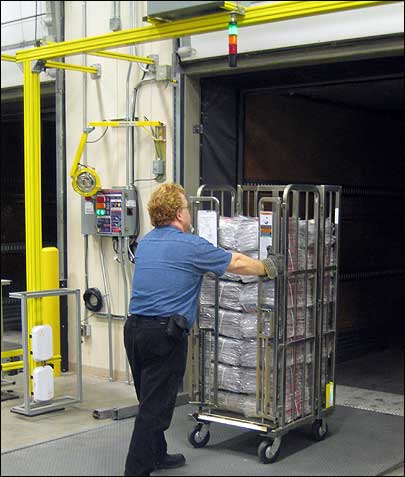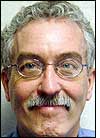The Dallas Morning News recently expanded its advertising options by building a plant dedicated to the collating of advertising fliers and newspaper inserts based on the intended readership in specified geographical areas. With its new South Plant, in Dallas, the newspaper sends 600,000 packages of inserts with each week’s Sunday paper in about 300 different arrangements, depending on the readers’ location. A flier for a store in one suburban area, for instance, would appear only in newspapers circulated in that specific locale—not in every newspaper delivered throughout the entire Dallas/Fort Worth readership.
The company is employing an RFID-enabled tracking system to ensure those packages—which are transported on metal carts to 12 distribution centers—are transported on the correct truck to the right DC. The system, known as RF SmartCart Tracking System, was provided by Cannon Equipment and went fully live this month.

Beginning early each week, the company collates fliers and inserts into unique packages. Once the appropriate inserts are assembled for a specific location, the packages are bundled together and shipped to one of the publisher’s newspaper distribution centers. There, they are divided once more into specific groups, then inserted into the Sunday edition before being picked up by individual newspaper carriers.
There are two challenges to such an elaborate system, says Pat Geraghty, Cannon Equipment’s print technologies director: One is ensuring the right fliers and inserts go to the correct distributor for a given geographical area, and the other is tracking the 4,000 carts themselves, which are shipped to distributors, then returned to the plant.
“Our supply chain is inherently complex,” says Bill May, the Dallas Morning News‘ VP of operations. “We wanted to increase and safeguard the bundle integrity by verifying that we have loaded the right product onto the right truck for the right distribution center.”
The Dallas Morning News had already been using Cannon Equipment’s machines to automatically load carts for shipping. Now, the newspaper has added Alien Technology‘s tags and interrogators to the system, using them to help track its carts from the plant to the distribution center.
When packages are assembled into a bundle and given a bar-coded label, that label is scanned, connecting its bar-coded number with the destination to which the package will be sent. At that time, metal carts are wheeled into the station to be loaded, each with a passive EPC Gen 2 RFID tag attached to it, encoded with a unique RFID tracking number linked to the cart’s serial number.
An Alien 9800 interrogator captures the cart’s tag ID number, and a Cannon NCL Series II cart loader mechanically loads the cart with about 40 insert bundles. The RFID reader communicates data, via an Ethernet cable connection, to a PC workstation with a Web-based server. As the cart is loaded with specific bundles, the system is updated to show which truck and DC should receive it.
When the cart is pushed onto the truck, it passes through one of eight dock doors, each equipped with another Alien 9800 portal reader. If the cart passes through a dock door corresponding to an inappropriate distribution center for its load, an alert is triggered, letting the staff know the cart is being incorrectly routed. The dock door readers are also connected to PC work stations via an Ethernet cable, so the system updates Cannon’s Cart Operating and Management Enterprise Tracking (Comet) software to indicate a cart filled with bundles has been shipped.
Each of the 12 distribution centers has Alien interrogators at its dock doors, and these devices capture the cart tag’s ID number, thereby notifying the system that a shipment has been received. As the empty carts are shipped back to the plant, their tags are read once more, providing visibility regarding the locations of empty carts.
With the RFID system, Geraghty says, the newspaper knows which cart was loaded and with which inserts, as well as which truck it was loaded onto and when, which distribution center it arrived at and when, and how many empty carts are located in trucks. That data is accessible to any Dallas Morning News employee with user rights to the network. The newspaper can also provide data to advertisers, assuring them their content was shipped to the appropriate distributor.
The system’s deployment went smoothly, May says, noting, “The installation and bringing the system up on line has been relatively seamless for us.” The high-level of metals, however, posed some difficulties. “The carts are made of steel tubing, which presented particular challenges in setting up the RFID portal for accurate reads,” Geraghty explains. “We used a combination of antenna positioning, attenuation adjustments and software to optimize the portals.”
One future goal, according to Geraghty, would be to extend the tracking of inserts, as well as newspapers, further into the distribution system. The system, as it is currently set up, tracks Dallas Morning News inserts only to the distribution centers. At that point, inserts are handed out to delivery contractors, who place them inside newspapers and deliver the completed editions to their final destinations (such as homes, retail locations or vending machines). Tracking the hand-off of the inserts or papers to these delivery contractors could be accomplished through a combination of RFID and bar codes.
“Longer-term,” Geraghty says, “RFID tagging of each paper could provide tracking to its final destination—the customer.” May says he hopes to see a contiguous loop in the entire newspaper supply chain visibility such as Geraghty describes, but that he can not estimate when that might occur.


